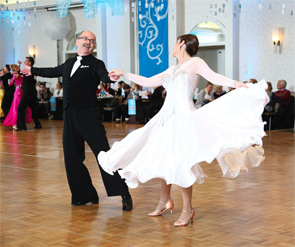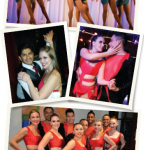Typically, he explains that all dancers wear suede-bottom shoes so they can easily turn and grip the floor at the same time. Only those competing at higher levels wear fancy costumes. Just as well. If purchased new, he says, men’s attire generally runs under $1,000, and women’s gowns can cost $3,000 each off the rack.
During his first competition, Dr. Miller wasn’t focused on anyone’s clothing.
“I was nervous, especially as the man, being the leader,” he recalls. “You’re trying to lead your partner, trying to remember your steps, trying to listen to the music, all at the same time. There’s a lady in your arms, so you don’t want to look too silly.”
In the early days, he says he took home many trophies from competitions, because sometimes, he and his dance teacher were the only couple on the dance floor in their category.
“In those days, I probably collected 50 trophies in the newcomer and bronze divisions,” he says, explaining that there are four amateur categories of competition—newcomer, bronze, silver and gold.
As the years passed, he was ready for bigger challenges and enrolled in dance lessons at the Arthur Murray Dance Studio in Minneapolis, a mere 240-mile drive from Fargo. He spent many weekends in the city, receiving several hours of both group and individual dance lessons every month.
Then in 1991, he met Joan, his future wife, now a chief master sergeant (ret.) in the Air National Guard. “She fell in love with me and ballroom dancing,” he says. Joan soon became his partner and joined him in taking dance lessons as a couple at independent dance studios in Minneapolis.
After they were married in 1992, the pair competed together during the next five years, entering amateur competitions in the American Smooth division. He prefers this style of dancing, he says, because there are fewer restrictions than the International Smooth category, in which couples have to remain in body contact at all times.
Better Teacher, Better Marriage

Dr. and Mrs. Miller dance a waltz at the January 2016 Snow Ball in Minneapolis.
From 1997 to 2014, the couple took a hiatus from competitions—but not social dancing—due to grueling work and personal schedules. Recently, they began teaching a social dance class, coaching college students at NDSU, and returned to competition last year.
“We’ve got to be on the cutting edge of our own dancing if we’re going to be credible with our students,” Dr. Miller says, adding that he and his wife will be competing in the national amateur championships in Baltimore this April.


